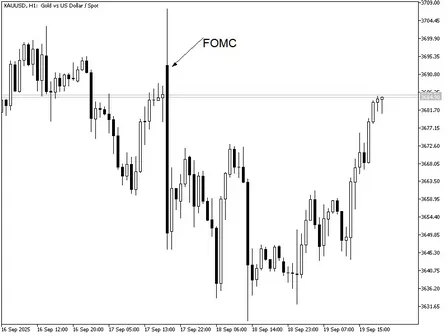Forex
+100 assets
Content table
1 mount ago
4 min read
Written by Greenup24
The Federal Reserve is lowering interest rates in an effort to mitigate economic stress. At its September 16–17, 2025 meeting, the Federal Open Market Committee (FOMC), in line with market expectations, reduced the federal funds rate by 25 basis points, bringing the target range to 4.00% to 4.25%. This move, which financial analysts including experts at Greenup24 consider a turning point for the U.S. economy, comes after a long period of contractionary policy aimed at controlling inflation. The Fed has now initiated a path of gradual interest rate cuts, indicating a significant shift in its monetary policy approach.
This shift has broad implications for financial markets and may affect gold prices, stock indices, and exchange rates. Initial reactions in the gold market suggest that investors are closely tracking the Fed’s decisions and expect the new policy to influence price trends. The one hour chart below shows the volatility in gold prices following the announcement.

Alongside this decision, the Fed released an updated Summary of Economic Projections (SEP), which presents a more optimistic outlook for the U.S. economy. The report suggests that policymakers have gained greater confidence in the resilience of the economy. Key details from the SEP include:
After the FOMC meeting concluded, Fed Chair Jerome Powell explained that the recent rate cut was primarily intended to address rising risks in the labor market. He described the decision as a “risk‑management cut,” citing evidence of weakening job growth and reduced labor demand. Powell also flagged two important contributing factors to labor market softness: a declining labor force participation rate and slower levels of immigration.
Powell emphasized that this does not mean the Fed will rush further rate reductions. Future policy decisions remain fully data−dependent. Although inflation has moderated somewhat, transient factors such as trade tariffs may continue to add temporary price pressures. Overall, these remarks make clear that the Fed is now approaching both inflation control and employment support with greater caution and nuance.
The Fed’s recent decision to cut rates represents a pivotal moment in U.S. monetary policy. It signals a shift in central bank priorities from solely fighting inflation toward a more balanced approach that also takes into account labor market challenges and the risk of economic slowdown.
In the past two years, the Fed’s dominant focus was reining in rising inflation through aggressive rate hikes. Now, as signs of labor market strain appear, policymakers appear to be moving toward a more balanced stance one that supports economic growth while still controlling inflation.
Despite the more favorable projections, there remains a high degree of uncertainty. Inflation dynamics are not entirely clear, and external factors including trade policy changes could temporarily disrupt price stability. Powell made it clear that future decisions are not locked in and will depend on upcoming economic data.
This approach signals that while the Fed is easing financial conditions, it remains committed to keeping inflation under control, using discretionary policy adjustments as needed.
A new chapter has begun in the Federal Reserve’s monetary policy. The 25 basis point rate cut sends a clear message: while inflation remains a concern, the Fed is increasingly attentive to risks in the labor market and the possibility of economic slowing.
This change in stance is likely to have a noticeable impact on the U.S. economy and financial markets in the coming months. Investors and market participants should monitor future economic data carefully and adjust their strategies to align with this evolving policy environment.
Greenup24.com offers traders the opportunity to experience real market conditions through a demo account, allowing them to test their skills and adapt strategies before committing real capital.

